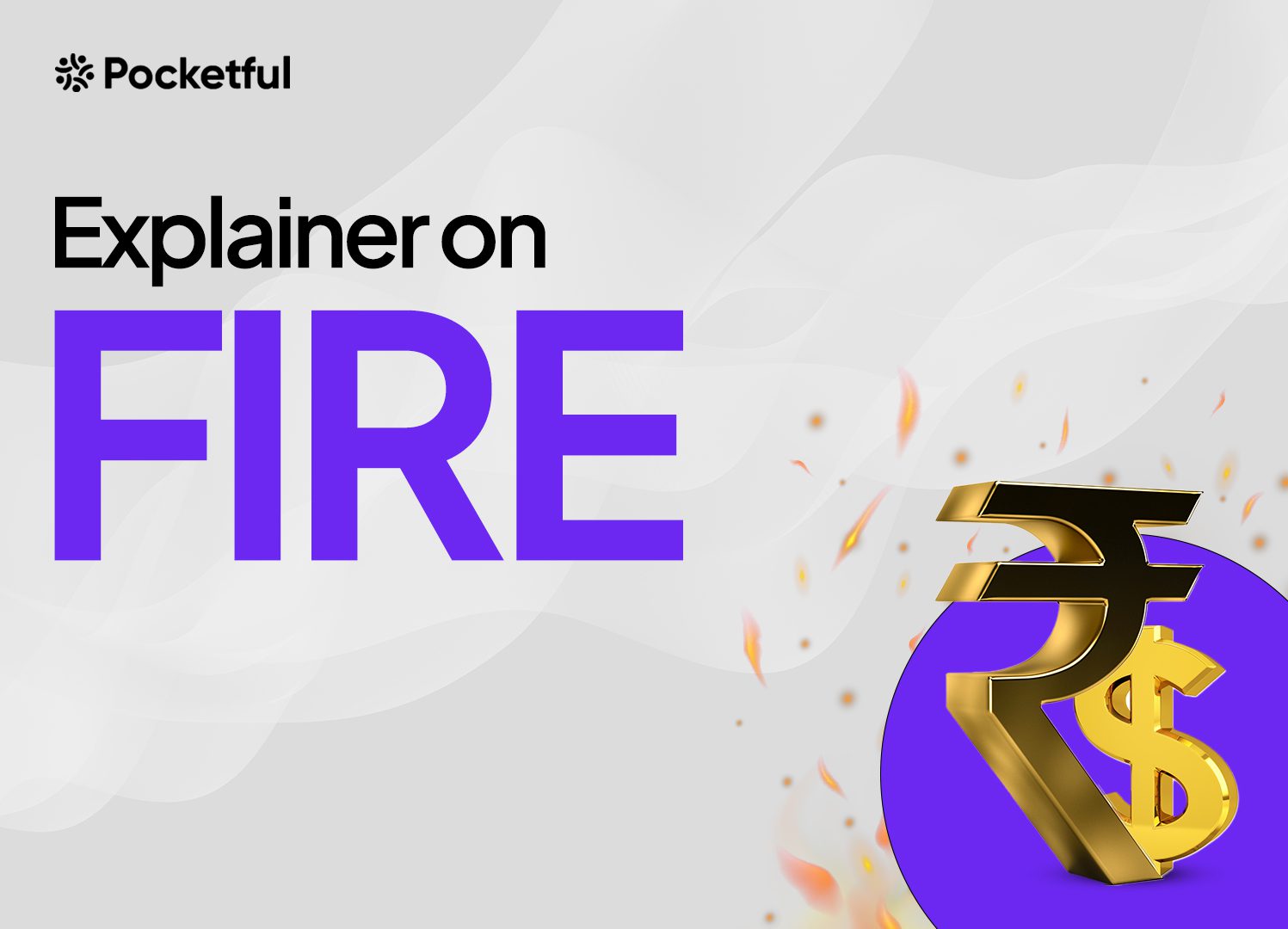| Type | Description | Contributor | Date |
|---|---|---|---|
| Post created | Pocketful Team | Apr-16-24 | |
| Internal linking | Nisha | Feb-17-25 |

- Blog
- what is fire in finance
What is FIRE in Finance? Full Form, Features, Types, and Formula Explained

Are you tired of your daily grind? Feeling trapped by your income? You are not alone. Millions crave financial freedom and the chance to break free from the traditional 9-5 job. But is early retirement possible?
This blog will dive deep into the world of FIRE and explore the sacrifices needed to achieve financial independence and early retirement.
Overview
FIRE stands for “Financial Independence Retire Early”. According to this theory, saving a bigger percentage of income and making prudent purchases throughout one’s earning years are the best ways for someone to retire early—typically in their 30s or 40s.
A person is typically expected to retire at age 60, but recently, people have a longing to retire early. The idea inspires many to save money to retire early and live a longer life.
Features
The major features of FIRE are as follows –
1. The concept focuses on retirement earlier than traditional retirement age.
2. Individuals should save a significant percentage of their income—more than 50%, on average.
3. It is recommended that savings are invested aggressively in high-yielding asset classes like bonds and stocks.
4. Implementation of the idea requires a minimalistic lifestyle, which means an individual is required to spend less and find cheaper alternatives to their habits.
5. Proper financial planning is required to achieve early retirement.
6. Discipline in saving funds is of paramount importance

Types of ‘FIRE’
The 3 major types of FIRE approaches are explained below-
1. Lean FIRE
Lean FIRE assumes a low spending rate after retirement. This means that you’ll have to sacrifice many of your aspirations and live within your means. If you’re willing to make those sacrifices, then Lean FIRE might be the right option for you because it is the fastest way to achieve your goals.
2. Fat FIRE
If you dream of international travel, lavish vacations, and shopping, Fat FIRE is the way for you. It allows users to save aggressively during their careers to have above-average retirement funds.
3. Barista FIRE
Individuals who follow the FIRE method are not interested in working a 9–5 job in the long term; instead, they engage in part-time work and live a modest lifestyle after retirement. To enjoy the freedom of work and the financial security of retiring early, many attempt to locate a less stressful job or work part-time after retirement.
Read Also: Military Wealth Management
How does ‘FIRE’ work?
If you intend to retire early, you must determine how much money you will need to continue living the way you do when you are retired. This will assist you in deciding when you can retire.
For example, a person with an annual income of 7 lakhs who intends to retire at 45 must have a different FIRE plan than someone with an annual income of 12 lakhs who wants to retire at 40.
FIRE strategy requires a unique approach, which typically includes cost-cutting and aggressive investing. One way to save costs is to purchase second-hand goods rather than brand-new ones or to spend on necessities only rather than wants. Individuals must set aside between 50 and 70 percent of their income for savings and use those funds to invest in various higher-yielding asset types, including bonds and stocks.
In addition to these two things, you must review your tax strategies to reduce the amount you pay for tax on your income.
To learn about your required retirement corpus, explore our Retirement Planning Calculator here.
Method of Calculating ‘FIRE’
1. To calculate FIRE, you need to determine your in-hand annual income first.
2. Next, you must determine your FIRE number using the widely accepted 4% thumb rule, which states that to maintain a 4% withdrawal rate, you must amass assets equal to 25 times your yearly expenses. For example – If your annual expenses are 5,00,000 INR, then your FIRE number would be 1,25,00,000, which is 25 times your annual expenses.
3. Then, you must adjust the FIRE number to include the impact of inflation.
4. The next step is to figure out how long it will take you to reach FIRE by factoring in your current savings rate, expenses, and investment return.
5. The next stage would be to decide which asset class to invest in.
6. Your portfolio must be periodically examined to assess investment performance and determine whether your FIRE objective is on track.

Advantages
FIRE offers several advantages to those who use it for their retirement planning, a few of which are mentioned below.
1. It gives someone the ability to feel adaptable and free to pursue the kind of life they desire.
2. An individual can have more time to follow their passions and hobbies when they retire early.
3. Individuals who are financially independent and have a solid financial plan lead stress-free lives free from financial uncertainty.
4. A person can leave a concentrated legacy through FIRE. Early retirement also enables one to spend more time with one’s loved ones.
Disadvantages
1. FIRE is vulnerable to uncertain and erratic returns on your investments; if the actual returns do not align with your retirement plan, you may not be able to secure enough money to retire.
2. It focuses heavily on giving up short-term needs in favor of early retirement and long-term financial security, which can cause mental dissatisfaction among users.
3. The growing cost of healthcare is not considered while accounting for retirement. This exposes the user to vulnerability during periods of a health crisis.
4. Inflation can erode purchasing power and reduce the value of your retirement savings. Hence, it is important to regularly modify the FIRE number in accordance with updated inflation figures.
Read Also: 10 Essential Financial Planning Tips for Military Members
Conclusion
The FIRE technique is a valuable strategy for early retirement and post-retirement financial independence. If you want to retire in your 40s, you should plan your retirement based on your lifestyle and income. You can apply any of the FIRE types to plan your financial future for yourself and your family. Furthermore, since retirement is a very personal choice, there is no one correct way to plan it; hence, you should do what is practical for you.
Frequently Asked Questions (FAQs)
What does FIRE stand for in financial terms?
FIRE refers to “Financial Independence Retire Early”.
What is the FIRE method?
It’s the process of making significant investments and savings during your formative years so that you can retire early.
How do you calculate your FIRE number?
To calculate your FIRE number, you must calculate your current annual expenses and multiply them by 25. This FIRE formula is derived using the 4% rule as a basis.
How can I plan my retirement by FIRE?
With the FIRE strategy, you can reduce your spending, save more money, and invest in high-yielding asset classes to prepare for retirement.
Is FIRE achievable for everyone?
Most people can achieve it because it just takes discipline, dedication, and smart financial planning. Your ability to achieve FIRE depends on your income level, your spending habits, and your ability to generate higher returns.
Disclaimer: The securities, funds, and strategies mentioned in this blog are purely for informational purposes and are not recommendations.
Disclaimer
The securities, funds, and strategies discussed in this blog are provided for informational purposes only. They do not represent endorsements or recommendations. Investors should conduct their own research and seek professional advice before making any investment decisions.